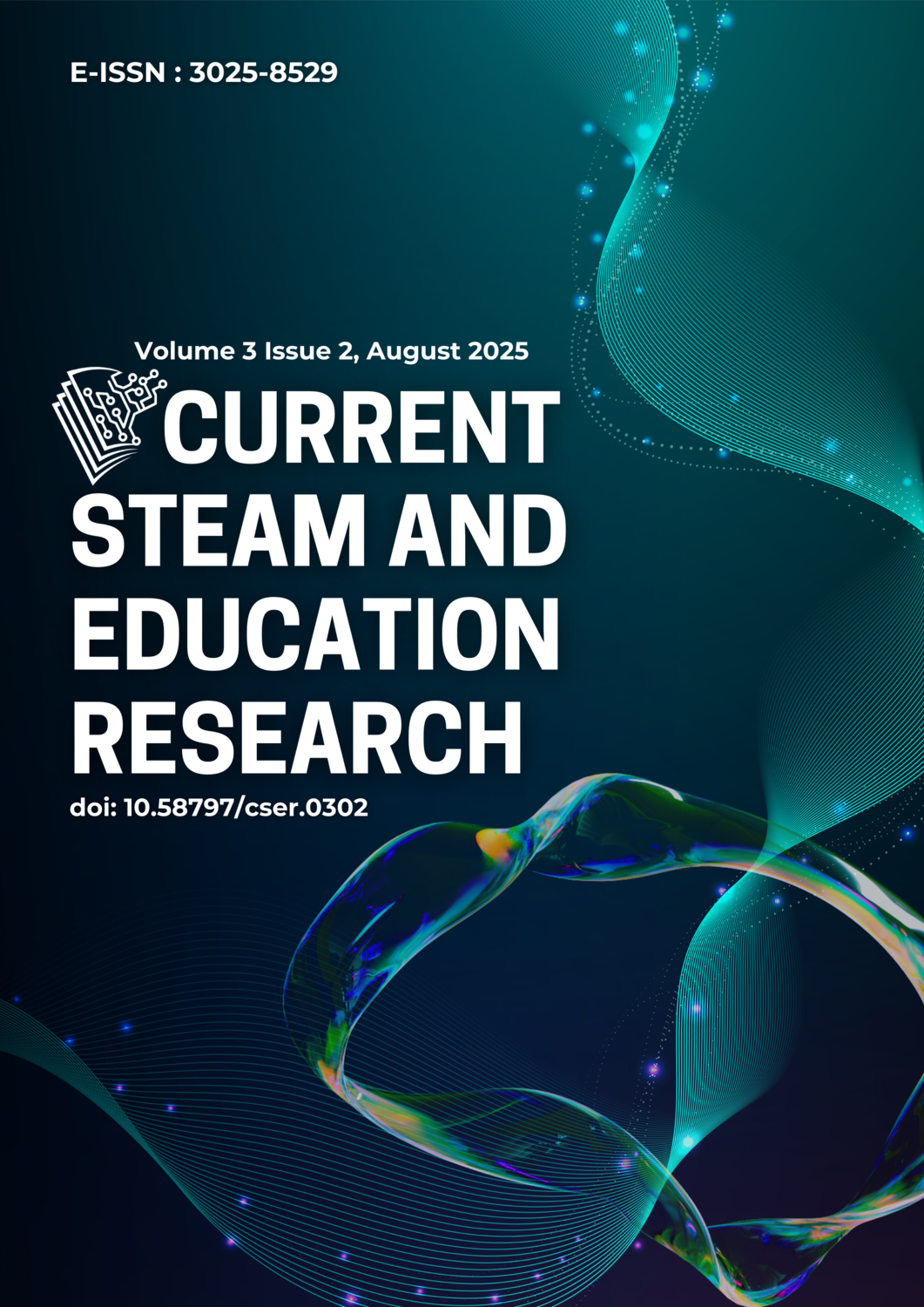Development of Student Worksheet for Magnetic Induction Practicum with Real-Time Data Logger Integration
DOI:
https://doi.org/10.58797/cser.030204Keywords:
magnetic induction, physics practicum, student worksheetAbstract
In order to enhance students' conceptual comprehension and practical physics learning abilities, this study intends to create a practicum worksheet on magnetic induction by incorporating data logger technology. Students frequently find the physics concept of magnetic induction to be difficult and abstract. To close the gap between theory and practice, a practical approach utilizing real-time data collection tools is crucial. The ADDIE (Analysis, Design, Development, Implementation, and Evaluation) model is the development model that was employed in this study. The needs of the students and the requirements of the curriculum were determined during the analysis phase. After that, the worksheet was created to help students with experiments involving data loggers based on Arduino that measure variations in magnetic fields brought on by induced currents. Limited trials were carried out in a classroom environment during the implementation phase, and assessments were carried out using student input and expert validation. The findings demonstrated that the worksheet was interactive, well-structured, and successful in encouraging scientific thinking while assisting students in carrying out experiments on their own. Better visualization of magnetic field variations and increased measurement accuracy were made possible by the incorporation of data logger tools. It is anticipated that this practicum worksheet will be a cutting-edge educational tool that promotes purposeful, technologically advanced physics instruction.
References
Adeyele, V. O. (2024). Relative effectiveness of simulation games, blended learning, and interactive multimedia in basic science achievement of varying ability pupils. Education and Information Technologies, 29(11). https://doi.org/10.1007/s10639-023-12414-z
Alexander, R., & Fuqua, M. (2024). Ruraling career guidance research and practice: learning from rural perspectives. International Journal for Educational and Vocational Guidance. https://doi.org/10.1007/s10775-024-09699-y
Coscia, A., Suh, A., Chang, R., & Endert, A. (2023). Preliminary Guidelines For Combining Data Integration and Visual Data Analysis. IEEE Transactions on Visualization and Computer Graphics, 30(10), 6678–6690. https://doi.org/10.1109/tvcg.2023.3334513
Costabile, M., Birbeck, D., & Aitchison, C. (2024). Using simulations to meld didactic and constructivist teaching methods in complex second year STEM courses. International Journal of Science Education, 47(2), 1–18. https://doi.org/10.1080/09500693.2024.2314010
Dostal, J. A. (2024). Applying physics education research to teaching. The Journal of the Acoustical Society of America, 156(4_Supplement), A118–A118. https://doi.org/10.1121/10.0035307
Errabo, D. D., & Ongoco, A. A. (2024). Effects of interactive-mobile learning modules in students’ engagement and understanding in genetics. Journal of Research in Innovative Teaching & Learning, 17(2), 327–351. https://doi.org/10.1108/jrit-01-2024-0023
Giovana, M., Serrano, A., & Treagust, D. (2024). Exploring the relationship between mental representations and conceptual understanding of Special Relativity by high school students. Research in Science & Technological Education, 1–26. https://doi.org/10.1080/02635143.2024.2446801
Harmer, M., Bennion, A., Hopps-McDaniel, A. M., Lawler, J., & Powers, N. (2024). Leveraging scientific modeling to engage pre-med undergraduates in physics lab courses. Physical Review Physics Education Research, 20(2). https://doi.org/10.1103/physrevphyseducres.20.020150
Kilpeläinen-Pettersson, J., Koskinen, P., Lehtinen, A., & Mäntylä, T. (2025). Cooperative Learning in Higher Education Physics – A Systematic Literature Review. International Journal of Science and Mathematics Education. https://doi.org/10.1007/s10763-024-10538-3
Kok, K., & Priemer, B. (2023). Assessment tool to understand how students justify their decisions in data comparison problems. Physical Review Physics Education Research, 19(2). https://doi.org/10.1103/physrevphyseducres.19.020141
Li, H., Xing, W., Li, C., Zhu, W., & Oh, H. (2024). Are simpler math stories better? Automatic readability assessment of GAI‐generated multimodal mathematical stories validated by engagement. British Journal of Educational Technology, 56(3), 1092–1117. https://doi.org/10.1111/bjet.13554
Lichtenberger, A., Hofer, S. I., Stern, E., & Vaterlaus, A. (2024). Enhanced conceptual understanding through formative assessment: results of a randomized controlled intervention study in physics classes. Educational Assessment Evaluation and Accountability, 37(1). https://doi.org/10.1007/s11092-024-09445-6
Lim, I. (2024). A design framework for educational escape rooms in STEM: CREATE. Research in Science & Technological Education, 1–16. https://doi.org/10.1080/02635143.2024.2431273
Lin, C.-J., Wang, W.-S., Lee, H.-Y., Huang, Y.-M., & Wu, T.-T. (2024). Interventions in STEM Education Through Speech Recognition-Based Learning Analysis. Journal of Educational Computing Research, 63(2), 311–335. https://doi.org/10.1177/07356331241307904
Mandal, S., Mantilla, H. M., Loganathan, K., Faber, H., Sharma, A., Gedda, M., Yengel, E., Goswami, D. K., Heeney, M., & Anthopoulos, T. D. (2025). Ultra‐Fast Moisture Sensor for Respiratory Cycle Monitoring and Non‐Contact Sensing Applications. Advanced Materials. https://doi.org/10.1002/adma.202414005
Ojetunde, S. M., & Ramnarain, U. (2025). Like objects or like subjects? Effects of student–robot interaction (SRI) and mathematical ability on students learning outcomes. Smart Learning Environments, 12(1). https://doi.org/10.1186/s40561-024-00345-2
Reyes, R. L., Isleta, K. P., Regala, J. D., & Mae, D. (2024). Enhancing experiential science learning with virtual labs: A narrative account of merits, challenges, and implementation strategies. Journal of Computer Assisted Learning, 40(6). https://doi.org/10.1111/jcal.13061
Skulmowski, A. (2024). Learning by Doing or Doing Without Learning? The Potentials and Challenges of Activity-Based Learning. Educational Psychology Review, 36(1), 28. https://doi.org/10.1007/s10648-024-09869-y
Sondermann, C., Huff, M., & Merkt, M. (2024). Distracted by a talking head? An eye tracking study on the effects of instructor presence in learning videos with animated graphic slides. Learning and Instruction, 91, 101878–101878. https://doi.org/10.1016/j.learninstruc.2024.101878
Wang, Q., & Cai, X. (2023). Active-Learning Class Activities and Shiny Applications for Teaching Support Vector Classifiers. Journal of Statistics and Data Science Education, 32(2), 202–216. https://doi.org/10.1080/26939169.2023.2231065
Weber, J., & Wilhelm, T. (2024). Contributing factors to the improvement of conceptual understanding in a computer-based intervention in Newtonian dynamics. Physical Review Physics Education Research, 20(2). https://doi.org/10.1103/physrevphyseducres.20.020130
Yin, W., Li, H., Zhao, Z., Qiao, S., & Sun, Y. (2025). Revolutionizing fluid identification in well logging data with a novel framework of progressive gated transformers and multi-scale temporal features. Physics of Fluids, 37(1). https://doi.org/10.1063/5.0245543
Downloads
Published
How to Cite
Issue
Section
License
Copyright (c) 2025 Early Amada, Handjoko Permana

This work is licensed under a Creative Commons Attribution 4.0 International License.
